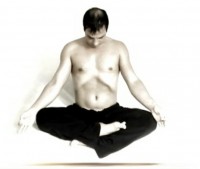Pranayama involves sitting for long periods of time and performing breathing.
In order to learn pranayama we must also learn the art of sitting.
TRADITIONALLY PRANAYAMA WAS PRACTICED IN FULL LOTUS POSE!
Only do this if you can do it with ease. Sitting in Half Lotus does not provide as firm a base. Forcing yourself into either pose is not going to do you any favors. Try sitting on a nice seat that promotes a proper upright spine. Most seats make you slouch (Curve your spine forward) so put cushions behind your lower back.
Stiffness causes aches and pains that distract the practitioner
continually sending signals of uncomfort, pain and frustration to the mind. Therefore practice stretches before you enter a seated posture.

Try rocking your body forward and back in Half Lotus pose always being careful with the knees as it is hard on many parts of these joints. This can be done for a few minutes on each side.

Open the legs and stretch the hamstrrings and inner groin. This also counter balances the Half Lotus Stretch which seems to stretch all the outside muscles and ligaments in the knees.
 These stretches can be done before, during and after stretching in Half Lotus (the cross legged pose above) or full Lotus pose. If my legs get sore while performing Pranayama, which they do always as each session is at least 45 minutes, I stretch and move around so that blood flow increases and nerve energy can move along the blocked channels again. Do these stretches during your practice, breaking out of the breathing and performing them, and you will find more comfort and ease during practice. Do them after so that you can get up and walk around without limping with stiffness.
These stretches can be done before, during and after stretching in Half Lotus (the cross legged pose above) or full Lotus pose. If my legs get sore while performing Pranayama, which they do always as each session is at least 45 minutes, I stretch and move around so that blood flow increases and nerve energy can move along the blocked channels again. Do these stretches during your practice, breaking out of the breathing and performing them, and you will find more comfort and ease during practice. Do them after so that you can get up and walk around without limping with stiffness.
Flexibility helps you hold a seated posture for longer periods of time and there are
many yoga asana that can be
performed to enhance the flexibility necessary to sit comfortably.

Cobra Pose helps to open the chest and lower back. It is good to combine this pose with the ones above so that there are not too many forward bends.
Here is an example of a sequence you can do. There are many and it is best to listen to your body for which direction to go. This is just an example of one of hundreds:














The splits postures can be done one way and then the other. You can keep the sequence simple by doing one pose one way and then the opposite way which is the most balanced way but sometimes it's better to flow into many in a row as the poses blend well when one that is close to another is entered instead of the same pose the opposite way. You can do 5 poses in a row (any number) then do the same 5 the opposite way.
There are lot's of ways to open the body so experiment and feel how your body responds.
Use a cushion or towel to raise the pelvis. This increases the tilt allowing more
space for the diaphragm. It also saves you stretching all the time.
Keep an upright spine while sitting. Allow a little looseness so that the muscles
around the chest and torso have plenty of room to move and expand.
The head tilts down in traditional pranayama. If the neck muscles are stiff this
can be challenging. If the area is too tight blood and oxygen flow is restricted.
In these cases a mild tilt will produce better results in pranayama.
If this continues to cause problems keep the head upright.
The lower back often moves out of alignment if the muscles are inflexible or
if the mind wanders away from the breath. Be aware of this and always
allow space around the front of the belly and below the navel.
The sitting posture may loose its integrity over time during a pranayama session.
The volume of air that can be taken into the lungs reduces when this occurs.
Keep the seated posture firm and upright.
Do some Yoga Asana to help if pain and discomfort is causing major
distraction.
Feel free to break out of a pranayama practice and into a
few yoga
postures shown below or similar exercises to relieve and
stretch the back and hips.
Find exercises that help relieve the pain and
improve your seated posture.
Choose postures that are no strain to the nervous system and require little effort.
Choose postures that stretch the muscles that are acting against the body.
Some postures that may help your seated pranayama pose are below:


















